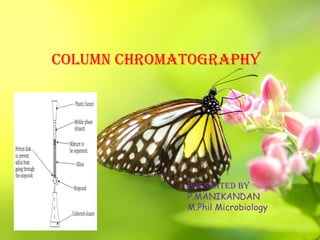
Cc seminar
- 1. COLUMN CHROMATOGRAPHY PReseNTed bY P.MANIKANDAN M.Phil Microbiology
- 2. HISTORY Column Chromatography was developed by the American chemist D.T Day in 1900, M.S. Tswett the Polish botanist, in 1906 used adsorption columns in his investigations of plant pigments.
- 3. INTRODUTION: Chromatography is the term used to separation technique. Mobile phase carrying a mixture is caused to move in contact with a selectively absorbent stationary phase. There are different kinds of chromatography, which differ in the mobile and the stationary phase used. Column chromatography is one of the most useful methods for the separation and purification of both solids and liquids.
- 4. PRINCIPLE: When a mixture of mobile phase and sample to be separated are introduced from top of the column. Individual components of mixture move with different rates. Those with lower affinity and adsorption to mobile phase move faster and eluted out first while those with greater adsorption affinity move or travel slower and get eluted out last. The solute molecules adsorb to the column in a reversible manner. A compound attracted more strongly by the mobile phase will move rapidly through the column, and elute from, or come off, the column dissolved in the eluent.
- 5. In contrast, a compound more strongly attracted to the stationary phase will move slowly through the column. However, polarity as seen the most important factor in adsorption chromatography. Different mobile phases used: Petroleum ether, carbon tetrachloride, cyclohexane, ether, acetone, benzene, toluene, esters It can be used in either pure form or as mixture of solvents
- 6. Selection of Stationary Phase 1.Removal of impurities 2.No. of components to be separated 3.Length of the column used 4.Quantity of adsorbent used
- 7. Mobile Phase 1. They act as solvent, developer & eluent. The function of a mobile phase are: 2. To introduce the mixture into the column – as solvent 3. To developing agent 4. To remove pure components out of the column – as eluent
- 8. Adsorbents: The usual adsorbents employed in column chromatography are silica, alumina, calcium carbonate, calcium phosphate, magnesia, starch, etc., Alumina is generally suitable for chromatography of less polar compounds. Silica gel gives good results with compounds containing polar functional groups.
- 9. PREPARATION OF THE COLUMN: It consists of a glass tube with bottom portion of the column – packed with glass wool/cotton wool or may contain asbestos pad, Prepare slurry (silica) Slurry pour the column Load the sample Collection of fraction Screening of fractions
- 10. Packing techniques in C.C There are two types of preparing the column, they are: I. Dry packing / dry filling II. Wet packing / wet filling The column should be free from impurity, before using column, it should be washed properly and dry it. Before filling column with stationary phase, cotton/glass wool is kept It should be uniformly filled
- 11. Dry Packing Technique Adsorbent is packed in the column in dry form Fill the solvent, till equilibrium is reached DEMERIT: Air bubbles are entrapped b/w M.P & S.P→ cracks appear in the adsorbent layer. • After filling tapping can be done to remove void spaces.
- 13. Wet Packing Technique: ideal & common technique The material is slurry with solvent and generally added to the column in portions. S.P settles uniformly & no crack in the column of adsorbent. Solid settle down while the solvent remain upward. This solvent is removed then again cotton plug is placed.
- 14. Introduction of the Sample The sample which is usually a mixture of components is dissolved in minimum quantity of the mobile phase. The entire sample is introduced into the column at once and get adsorbed on the top portion of the column. From this zone, individual sample can be separated by a process of elution.
- 16. DETECTION OF COMPONENTS: If the compounds separated in a column chromatography procedure are coloured, the progress of the separation can simply be monitored visually. Small fractions of the eluent are collected sequentially in labelled tubes and the composition of each fraction is analyse by TLC. Further analysis using GC-MS, NMR (Non Magnetic Resonance).
- 17. • Eluting the sample: Components a, b, and c separate as column progresses. • Fractions can be collected in test tubes, vials, beakers, or Erlenmeyer flasks.
- 18. Analyzing the fractions: • Analyze the fractions by thin-layer chromatography
- 20. APPLICATIONS: Separation of mixture of compounds Purification process C.C is best suited to separate active principle from plant materials To separate or purify natural compound mixtures like alkaloides, glycosides.
- 21. ADVANTAGES OF C.C Any type of mixture can be separated Any quantity of mixture can be separated Wider choice of Mobile Phase Automation is possible DISADVANTAGES OF C.C Time consuming more amount of Mobile Phase are required Automation makes the techniques more complicated & expensive
- 22. PRECAUTIONS: Keep the column in a clean and dust free place. Avoid gaps within the stationary phase packing. Do not distrub the column till the separation is complete.